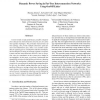Free Online Productivity Tools
i2Speak
i2Symbol
i2OCR
iTex2Img
iWeb2Print
iWeb2Shot
i2Type
iPdf2Split
iPdf2Merge
i2Bopomofo
i2Arabic
i2Style
i2Image
i2PDF
iLatex2Rtf
Sci2ools
IPPS
2006
IEEE
2006
IEEE
Dynamic power saving in fat-tree interconnection networks using on/off links
Current trends in high-performance parallel computers show that fat-tree interconnection networks are one of the most popular topologies. The particular characteristics of this topology, that provide multiple alternative paths for each source/destination pair, make it an excellent candidate for applying power consumption reduction techniques. Such techniques are being increasingly applied in computer systems and the interconnection network is not an exception, since its contribution to the system power budget is not negligible. In this paper, we present a mechanism that dynamically switches on and off network links as a function of traffic. The mechanism is designed to guarantee network connectivity, according to the underlying routing algorithm. In this way, the default routing algorithm can be used regardless of the power saving actions taken, thus simplifying router design. Our simulation results show that significant network power consumption reductions can be obtained at no cos...
Distributed And Parallel Computing | Interconnection Network | IPPS 2006 | Power Consumption Reductions | Routing Algorithm |
Related Content
| Added | 12 Jun 2010 |
| Updated | 12 Jun 2010 |
| Type | Conference |
| Year | 2006 |
| Where | IPPS |
| Authors | Marina Alonso, Salvador Coll, Juan Miguel Martínez, Vicente Santonja, Pedro López, José Duato |
Comments (0)

